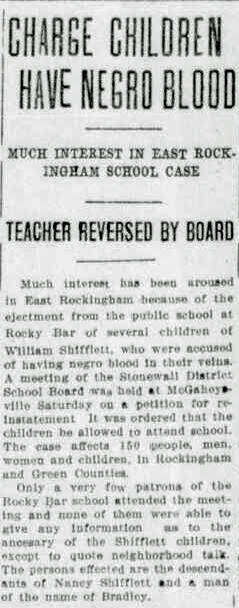When historians look back on 2020, no doubt attention
will be given to the global pandemic of Covid-19. Of equal if not more interest
will be the racial tensions that escalated following the death of George Floyd
at the hands AND KNEE of Minneapolis police. In my lifetime racial tension has
been a fact of life. I was a teenager when public schools were mandated to
integrate. That was about 50 years after a dirty little secret about race and
public education revealed itself.
In 1910 the State of Virginia passed an act prohibiting
children with one-sixteenth negro blood to enroll in public school. Five years
later, Miss Price, the teacher at the Rocky Bar mission school in Rockingham
County, put that law to the test. With only the word of neighborhood gossips as
proof, Miss Price reported to the Rev. J. R. Ellis, who was in charge of the
mission schools in the eastern part of the county, that several children of
William Shifflett needed to be expelled because of their questionable heritage.
The word back in the holler was that William was the great-grandson of Nancy
Shifflett and a man named Bradley, ostensibly a “negro.”
Kicking those little children out of school caused quite
a stir. The case was finally brought to the School Board when the Shifflett
family petitioned the Board to have the children readmitted. The family argued
that they married as white, attended white churches, went to white schools, and
that, in fact, Bradley was actually Mexican. In their corner was lawyer Charles
Hammer who could explain the mathematics of genealogy. As he pointed out, even
if Bradley were half-black, the blood of William Shifflett’s children would
have been only one-thirty-second black therefore making the children eligible to attend white
schools.
 |
| From Harrisonburg Daily News Record 25 Jan 1915 |
No one seemed to want to take the blame for what turned
out to be an unpopular decision about the Shifflett children. Miss Price said
it was Rev. Ellis’s authority to expel the children. He said Miss Price did it.
School Board members claimed ignorance of the situation until the petition was
presented to them. To everyone’s credit, it did not take the School Board long
to reverse the teacher’s order and welcome the children back to school.
Amy Johnson Crow continues to challenge genealogy
bloggers and non-bloggers alike to think about our ancestors and share a story
or photo about them. The challenge is “52 Ancestors in 52 Weeks.”
Wendy
© 2020, Wendy Mathias. All rights reserved.



Wonder what was going through the children's minds through all this. Wonder how it affected the rest of their lives and their dealings with people of other races.
ReplyDeletebetty
History is full of such sad stories. It breaks my heart for the Shifflet family. Even though the decision was reversed, there had to be so much hurt and frustration as they worked through the process.
ReplyDeleteI have a friend in our retirement community whose father, a minister, took a case all the way to the Supreme Court to get the schools to integrate in South Carolina. Her mother taught at the Black school using outdated textbooks and discarded, battered desks from the White school. So, this is within our lifetime, and there is still much work to do to improve equality. Thanks for this timely post.
ReplyDeleteYes, the changes we've witnessed! Slow moving.
DeleteBetty and Michelle, I am right with you. All I can think about was how horrible this had to be for the children. Surely a mixed-race carried a lot of shame and left children open to a major bully-fest. Just so sad.
ReplyDeleteIt's amazing what we have witnessed in our lifetime and I know each generation has their own set of changes. I just blogged about the letters my grandparents wrote back and forth from 1916-1919 and they talked a lot about the Spanish flu, wearing masks, etc. And here we are repeating it 100 years later.
ReplyDelete